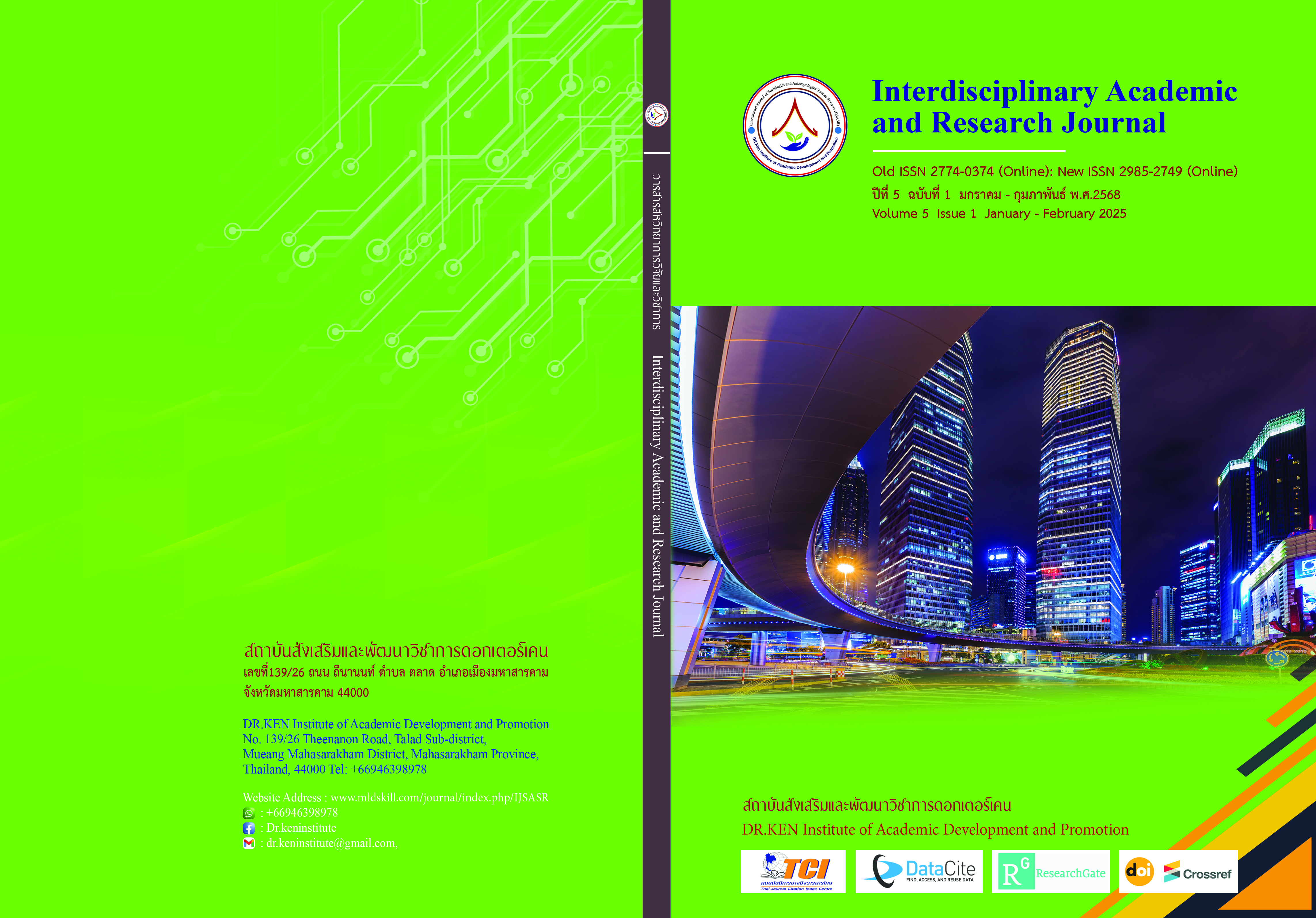Developing the Achievement of Diphthongs of Students in Grade 2 by Using the CIPPA Learning Activities to Accompany the Skill Practice
DOI:
https://doi.org/10.60027/iarj.2025.271983Keywords:
Reading and writing diphthongs, Cippa learning activities, Skill exercisesAbstract
Background and Aims: The Thai language is a national identity. It is a cultural property that creates unity and strengthens the personality of the nation to be Thai. It is a communication tool to create understanding and good relationships with each other. This makes it possible to conduct business, work, and live in a democratic society in peace. and is a tool for seeking knowledge and experience. Thus, the purpose of this research is to 1. Development of learning activities in the Thai language subject, topic diphthongs, Thai language learning group of 2nd-grade students by using CIPPA learning activities with skill practice exercises to be effective according to the criteria of 80/80 2. Compare the learning achievement in the Thai language subject on diphthongs of students in grade 2 by using CIPPA learning activities combined with skill practice exercises. between before class and after class, and 3. Study satisfaction with the development of Thai language learning on diphthongs of Grade 2 students by using CIPPA learning activities.
Methodology: The research sample consisted of 28 Grade 2 students using the Cluster Random Sampling technique. The research tools included: 1. Thai language learning group learning plan on the subject of compound words. 9 sets of skill practice exercises for the Thai language learning group on diphthongs. 2. Achievement test on diphthongs before class and after class. 3. Satisfaction questionnaire and Statistics used in data analysis include mean, percentage, standard deviation, and t-test using Dependent Samples (t-test dependent).
Results: The learning management plan includes skill training exercises for the Thai language subject group on diphthongs for Grade 2 with an efficiency of 85.42 / 86.96, which is more effective than the set criteria of 80/80. Achievement in reading and learning. write diphthongs by using CIPPA learning activities combined with skills. of 2nd-grade students after studying is higher than before studying. Statistically significant at the .05 level. Students are satisfied with the use of CIPPA learning activities combined with skills. At a very satisfied level.
Conclusion: The study demonstrates the high effectiveness of a skill-based group learning management plan for Grade 2 Thai language concordance, exceeding the established criteria. The integration of skill-based learning activities results in significant improvements in reading and writing proficiency, supported by statistical significance. Furthermore, students express a high level of satisfaction with this learning approach, highlighting its positive impact.
References
กรมวิชาการ กระทรวงศึกษาธิการ. (2544). หลักสูตรการศึกษาขั้นพื้นฐาน พุทธศักราช. 2544. กรุงเทพฯ: องค์การรับส่งสินค้าและพัสดุภัณฑ์
กัลยา พันปี. (2551). การเปรียบเทียบผลสัมฤทธิ์ทางการเรียนวิชาคณิตศาสตร์และทักษะการเชื่อมโยงทางคณิตศาสตร์ ของนักเรียนชั้นมัธยมศึกษาปีที่2 ระหว่างกลุ่มที่จัดการเรียนรู้รูปแบบซิปปา (CIPPA MODEL) และรูปแบบ วัฏจักรการเรียนรู้ (4 MAT). สารนิพนธ์ครุศาสตรมหาบัณฑิต (การจัดการการเรียนรู้) มหาวิทยาลัยราชภัฏพระนครศรีอยุธยา
ทิศนา แขมมณี. (2548). รูปแบบการเรียนการสอนทางเลือกที่หลากหลาย. พิมพ์ครั้งที่3. กรุงเทพฯ: จุฬาลงกรณ์มหาวิทยาลัย.
ทิศนา แขมมณี. (2560). ศาสตร์การสอน: องค์ความรู้เพื่อการจัดกระบวนการเรียนรู้ที่มีประสิทธิภาพ(พิมพ์ครั้งที่ 8). กรุงเทพฯ: แห่งจุฬาลงกรณ์มหาวิทยาลัย.
ประทินทิพย์ พรไชยยา. (2552). การเปรียบเทียบผลสัมฤทธิ์ทางการเรียน การคิดวิเคราะห์และเจตคติต่อการเรียนภาษาไทย ชุดภาษาเพื่อชีวิต (ภาษาพาที) ของนักเรียนชั้นประถมศึกษาปีที่ 5ระหว่างการจัดการเรียนรู้ตามแนวทฤษฎีพหุปัญญากับการจัดการ เรียนรู้แบบซิปปา.วิทยานิพนธ์ กศ.ม. มหาสารคาม : มหาวิทยาลัยมหาสารคาม.
ประสพสุข ฤทธิเดช และคณะ. (2558). ทุนทางสังคมในการพัฒนาข้าวหอมนิลปลอดภัยของ โรงเรียนชาวนาเสริมสร้างคุณภาพชีวิต. ทุนวิจัยจำกสำนักงานคณะกรรมการวิจัยแห่งชำติ (วช.) ร่วมกับสำนักงานพัฒนาการวิจัยการเกษตร (สวก.) ประเภททุนมุ่งเป้าในการพัฒนาประเทศ โดยเร่งด่วนเรื่องข้าว.
รัดติยากร ชินกร. (2559). การพัฒนากิจกรรมการเรียนรู้การเขียนเชิงสร้างสรรค์โดยใช้รูปแบบซิปปา มหาวิทยาลัยราชภัฏมหาสารคาม. มหาสารคาม : มหาวิทยาลัยราชภัฏมหาสารคาม.
โรงเรียนกิตติรวี (2564). รายงานผลการประเมินตนเองของสถานศึกษา โรงเรียนกิตติรวี ตำบลคำใหญ่ อำเภอห้วยเม็ก จังหวัดกาฬสินธุ์. กาฬสินธ์: โรงเรียนกิตติรวี.
สุซาดา ขันเชื้อ. (2550). การเปรียบเทียบผลการเรียน เรื่อง มาตราตัวสะกด กลุ่มสาระการเรียนรู้ภาษาไทย ของนักเรียนชั้นประถมศึกษาปีที่ 3 โดยการสอนรูปแบบซิปปา (CIPPA MODEL) กับการจัดการเรียนรู้ตามคู่มือการจัดการเรียนรู้ มหาวิทยาลัยราชภัฏบุรีรัมย์.
สุนันทา มั่นเศรษฐวิทย์(2555).หลักและวิธีสอนอ่านภาษาไทย. กรุงเทพฯ : สำนักนายกรัฐมนตรี.
อภิชาต ศรีสารคาม.(2553). ความปลอดภัยในชีวิต กลุ่มสาระการเรียนรู้สุขศึกษาพลศึกษา ชั้นประถมศึกษาปีที่ 5. วิทยานิพนธ์ปริญญามหาบัณฑิต. บัณฑิตวิทยาลัยมหาวิทยาลัยมหาสารคาม.
Downloads
Published
How to Cite
Issue
Section
License
Copyright (c) 2025 Interdisciplinary Academic and Research Journal

This work is licensed under a Creative Commons Attribution-NonCommercial-NoDerivatives 4.0 International License.
Copyright on any article in the Interdisciplinary Academic and Research Journal is retained by the author(s) under the under the Creative Commons Attribution-NonCommercial-NoDerivatives 4.0 International License. Permission to use text, content, images, etc. of publication. Any user to read, download, copy, distribute, print, search, or link to the full texts of articles, crawl them for indexing, pass them as data to software, or use them for any other lawful purpose. But do not use it for commercial use or with the intent to benefit any business.
















.png)


